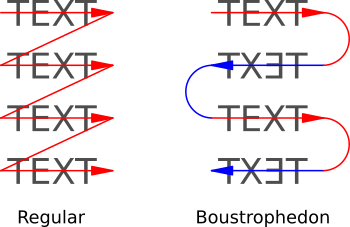Back • Return Home
On Reading (05/21/2020)
Our eyes do little jerky movements called "saccades" (from the French word for "jerk"). While they have a useful function, they may sometimes disrupt our reading, like when we repeatedly flick our eyes back to the beginning of a sentence. One way of transforming this tendency is to follow the tip of our finger with our eyes as we move it smoothly over lines of text in a sweeping motion. Eventually, this will help us to reduce "random" eye movements when reading, and keep us in a state that is focused yet relaxed.
There is a particularly elegant way of writing that facilitates this kind of eye movement called "boustrophedon" (which literally means "like the ox ploughs"). This is when lines of text alternate in direction. In other words, one line will move from left-to-right, and the line underneath it will move from right-to-left, and vice versa. Therefore, every other line is reversed. So instead of our eyes making a tight zig-zagging motion as we read, they undulate in a kind of wave pattern:
Another interesting aspect of reading is "sub-vocalization" (i.e.: when we read things as if we are speaking them out loud). Many people only read as fast as they can speak for this reason. However, it is possible to break this habit and learn to visualize chunks of sentences at a glance. Some "speed-reading" courses give exercises to help do this. For example, we can hum to quiet that "inner voice" while training our eyes to follow lines of text at a rate faster than if we read them out verbally.
In short, words represent things that we can "see" inwardly. We can get to a point where these images are triggered directly and we no longer "read aloud" things inside of our heads.
← Yesterday • Tomorrow →

